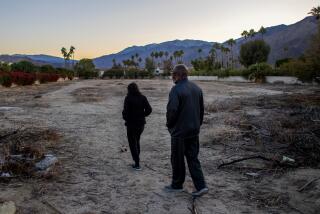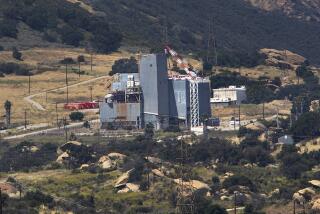Love Canal Showing Signs of Life : Pollution: Government says the area can be reinhabited. Although there are eager home buyers, banks are balking.
- Share via
NIAGARA FALLS, N.Y. — More than a decade has passed since Love Canal families fled their homes in panic. Government inspectors say the area has been cleared of toxic wastes and can be reinhabited.
Now it is the local banks, leery of granting mortgages, that are keeping prospective home buyers away.
“In our opinion, it’s the safest place to be,” said William Broderick, executive director of the Love Canal Area Revitalization Agency.
“Most people don’t know what’s in their back yards. But we know what’s in ours because it’s been tested.”
The Love Canal neighborhood, evacuated and sealed off in 1978 after a high incidence of birth defects and illness was attributed to chemicals leaking from an abandoned dump, had once been home to 480 families.
They packed their belongings, boarded up their houses and moved to other areas because of one of the nation’s worst pollution scares. Nearly 22,000 tons of chemical wastes, they discovered, had been dumped into a 15-acre area around Love Canal from 1942 to 1953.
After the alarm was sounded, some houses were demolished, the canal was capped with clay, and scientists tested and retested the pollution levels in the soil.
Today, many families want to buy homes in the 10-block zone once known as the Emergency Declaration Area. But most are finding that moving in may take a lot longer than it did for the evacuees to move out.
The Love Canal liability case ended Feb. 13 in U.S. District Court in Buffalo, and Judge John Curtin is expected to issue a decision in the next few months on whether federal, state and city governments and the school board must share blame for the incident with Occidental Chemical Corp.
In September, 1988, New York State Health Commissioner David Axelrod said about 240 homes north and west of the covered canal could be reinhabited.
The revitalization agency drew up a land-use plan and put its first home up for sale Aug. 16, 1990, and in only three months Broderick had 15 homes under contract.
But no bank in the area would accept a mortgage application on homes in Love Canal. Some bankers told clients there was no established market value for the property, while others worried that the federal Superfund law might make them liable for any future chemical leaks.
Patricia Colpoys, a 26-year-old schoolteacher, moved in anyway last June, into a three-bedroom, red brick ranch house on 98th Street. She found a bank to consider her mortgage application, but only after a Feb. 7 announcement by the U.S. Department of Housing and Urban Development that it would insure mortgages in the Love Canal area.
Broderick says he is optimistic that HUD’s decision will remove the only real obstacle to resettlement.
Before purchasing his home near Love Canal, Michael Oliveira did some research.
“As far as I could find, there was never any contamination or leakage that got anywhere near (my home),” he said. “I have a 6-year-old boy. There’s no way I would subject him to any health hazards.”
The homes, priced from $40,000 to $60,000, are refurbished by the agency before being resold. That is what encouraged Oliveira initially to sell his old house.
His new one has a new roof, vinyl siding, an insulated attic and an energy-efficient furnace.
About 30 families have followed Colpoys and Oliveira in repopulating the once-desolate neighborhood. Add to that about 55 homeowners who never left the area after the federal emergency was declared.
Now there are pockets of homes, with cars parked in driveways and porch lights illuminated, in what is still a virtual ghost town of about 200 vacant dwellings.
Colpoys said she did not mind being one of the first in the area. “It’s exciting to see people moving in,” she said.
Last June, Colpoys had one neighbor. Now, she has a handful who chat with her about home improvements, such as putting in a bay window or a swimming pool.
“I think now that HUD agreed to insure the mortgages, this neighborhood is really going to boom,” she said.
Broderick predicted that by the year 2000, most of the homes would be sold.
“You tear a neighborhood down, you don’t rebuild it any quicker,” he said. “If you build it right, it’s going to take time.”
Former residents of the area and environmentalists have opposed the resettlement effort.
Lois Gibbs, a former Love Canal resident and environmental activist, says repopulating the area could be dangerous to new residents and could set a precedent for resettling contaminated areas elsewhere in the country.
More to Read
Sign up for Essential California
The most important California stories and recommendations in your inbox every morning.
You may occasionally receive promotional content from the Los Angeles Times.













